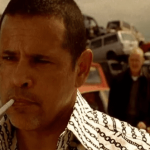 Our World
Our World  Our World
Our World  Weird Stuff
Weird Stuff 10 Fascinating Facts You Might Not Know About Snow
 Miscellaneous
Miscellaneous Top 10 Things Crypto Was Supposed to Change & What Actually Did
 History
History 10 Huge Historical Events That Happened on Christmas Eve
 Music
Music 10 Surprising Origin Stories of Your Favorite Holiday Songs
 History
History 10 Less Than Jolly Events That Occurred on December 25
 Weird Stuff
Weird Stuff 10 Funny Ways That Researchers Overthink Christmas
 Politics
Politics 10 Political Scandals That Sent Crowds Into the Streets
 Weird Stuff
Weird Stuff Ten Bizarre Facts About The Doge Meme
 Our World
Our World 10 Ways Your Christmas Tree Is More Lit Than You Think
 Our World
Our World 10 Archaeological Discoveries of 2025 That Refined History
 Weird Stuff
Weird Stuff 10 Fascinating Facts You Might Not Know About Snow
 Miscellaneous
Miscellaneous Top 10 Things Crypto Was Supposed to Change & What Actually Did
Who's Behind Listverse?

Jamie Frater
Head Editor
Jamie founded Listverse due to an insatiable desire to share fascinating, obscure, and bizarre facts. He has been a guest speaker on numerous national radio and television stations and is a five time published author.
More About Us History
History 10 Huge Historical Events That Happened on Christmas Eve
 Music
Music 10 Surprising Origin Stories of Your Favorite Holiday Songs
 History
History 10 Less Than Jolly Events That Occurred on December 25
 Weird Stuff
Weird Stuff 10 Funny Ways That Researchers Overthink Christmas
 Politics
Politics 10 Political Scandals That Sent Crowds Into the Streets
 Weird Stuff
Weird Stuff Ten Bizarre Facts About The Doge Meme
 Our World
Our World 10 Ways Your Christmas Tree Is More Lit Than You Think
10 Amazing Facts About 10 of the Most Popular Television Shows
Television has shaped global entertainment, providing viewers with countless hours of drama, laughter, and intrigue. From sitcoms that make us laugh until we cry to dramas that keep us on the edge of our seats, certain TV shows have transcended the small screen to become cultural phenomena. These series not only entertained millions but also set new benchmarks in storytelling, production, and character development. Here, we explore 10 amazing facts that reveal how some of the most popular television shows redefined the industry and captivated audiences worldwide.
Related: Top 10 Truly Terrible Television Series
10 The Cast’s Unbreakable Bond and Historic Pay Negotiation on Friends
One of the most amazing facts about Friends is the unity and solidarity of its cast. By the final two seasons, the six main actors—Jennifer Aniston, Courteney Cox, Lisa Kudrow, Matt LeBlanc, Matthew Perry, and David Schwimmer—were each earning $1 million per episode, making them some of the highest-paid actors in television history. What makes this even more remarkable is that the cast insisted on negotiating their salaries as a group, ensuring equal pay for all.
Initially, the actors were offered different salaries based on individual popularity, but David Schwimmer and Jennifer Aniston advocated for equal pay, leading the entire cast to negotiate collectively. This united front set a precedent in Hollywood and became a symbol of their off-screen friendship and loyalty.
The show’s creators credit this camaraderie for the series’ success and longevity. Throughout its 10 seasons, Friends maintained a consistent cast dynamic that was beloved by fans worldwide. Their historic negotiation remains one of the greatest examples of camaraderie and teamwork in the entertainment industry. This unity translated on-screen, creating a believable and relatable group of friends who continue to resonate with audiences long after the final episode aired.[1]
9 Revolutionizing Television Production with the Three-Camera Technique on I Love Lucy
An often unknown fact about I Love Lucy is how the show revolutionized the way sitcoms were filmed by pioneering the use of the three-camera technique. Desi Arnaz, who played Ricky Ricardo and was married to Lucille Ball, introduced this innovative filming method to capture the live performances of the show.
In the early 1950s, sitcoms were typically broadcast live or filmed using a single camera. Instead, Arnaz insisted on filming before a live studio audience with multiple cameras simultaneously capturing the action from different angles. This technique allowed for seamless editing, preserving the spontaneity of the performances while maintaining high production quality.
Moreover, I Love Lucy was one of the first sitcoms to be recorded on 35mm film, allowing for better preservation and syndication, which paved the way for future reruns. By being filmed in front of a live audience, the show’s creators could capture genuine laughter, adding an extra layer of authenticity to the comedic timing.
As a result, I Love Lucy became a pioneering force in the television industry, influencing the production style of countless sitcoms to come. Its success demonstrated the potential of multi-camera production, which remains the standard for many sitcoms today. Desi Arnaz’s vision transformed the sitcom landscape, making I Love Lucy a lasting legacy in television history.[2]
8 The Global Cultural Impact of the Transformers Franchise
The Transformers’ incredible journey from a simple line of Japanese toy robots to becoming a globally recognized multimedia franchise spans decades. In the early 1980s, Hasbro licensed two transforming robot toy lines from Japan: Takara’s Diaclone and Microman series. To introduce these toys to the American market, Hasbro partnered with Marvel Comics to create a backstory and universe for them. Thus, the Transformers brand was born in 1984, along with a comic book series and an animated television show.
The Transformers TV show quickly became a cultural phenomenon, leading to the production of The Transformers: The Movie in 1986. The brand then expanded into comic books, animated series, video games, and the highly successful live-action film franchise directed by Michael Bay, which has grossed over $4 billion worldwide.
The most remarkable aspect is how Transformers has continuously reinvented itself to captivate multiple generations of fans while maintaining its core appeal: the epic battle between Autobots and Decepticons. The introduction of new characters and storylines in subsequent series, such as Beast Wars and Transformers: Prime, helped the franchise stay fresh and relevant.
Its enduring legacy and ability to transcend cultural barriers make Transformers one of the most influential toy lines and multimedia franchises in history. It continues to resonate with audiences worldwide, proving that the battle between good and evil robots never goes out of style.[3]
7 Hugh Laurie’s Accent and Record-Breaking Salary on House M.D.
An amazing fact about House M.D. is how British actor Hugh Laurie convincingly portrayed the American character Dr. Gregory House and became one of the highest-paid actors in television history. Despite his native British accent, Laurie mastered an American accent so well that the show’s creator, David Shore, didn’t initially realize he was British during his audition. Laurie’s portrayal was so authentic that Bryan Singer, one of the show’s executive producers, called him “an incredible American actor.”
Laurie’s dedication to the role earned him critical acclaim and multiple awards. His sharp wit, complex character portrayal, and distinctive limp made Dr. House one of the most memorable characters in TV history. By the show’s final seasons, Laurie’s salary had skyrocketed to $700,000 per episode, making him one of the highest-paid actors in a television drama at the time.
His performance as the brilliant but misanthropic diagnostician became a defining aspect of the show, which ran for eight successful seasons. House M.D.’s global popularity helped redefine the medical drama genre and made Dr. Gregory House an unforgettable character. Laurie’s influence extended beyond the screen, as his impeccable American accent and sarcastic persona set a new standard for foreign actors taking on American roles.
Even after the show’s end, Hugh Laurie’s impact as Dr. Gregory House continues to be felt, as the character remains a touchstone for complex, flawed antiheroes in television dramas.[4]
6 The Show’s Game-Changing Influence on Television Drama in The Sopranos
The most amazing fact about The Sopranos is how it revolutionized the television landscape, paving the way for modern TV dramas with complex antiheroes. Created by David Chase and premiering in 1999, the series followed mob boss Tony Soprano, played by James Gandolfini, as he balanced his criminal empire with family life.
Before The Sopranos, television dramas rarely explored deeply flawed protagonists like Tony Soprano, who struggled with anxiety and depression while ruthlessly managing his crime organization. The show’s intricate storytelling, character development, and psychological depth set a new standard for TV dramas, influencing countless series that followed.
Moreover, The Sopranos was one of the first cable TV shows to gain mainstream popularity, proving that high-quality, mature storytelling could thrive on premium networks like HBO. It opened doors for other groundbreaking series such as The Wire, Mad Men, and Breaking Bad, which further explored morally ambiguous characters.
The series won 21 Primetime Emmy Awards and remains widely regarded as one of the greatest TV shows of all time. Its impact on the television industry is immeasurable, cementing its legacy as a game-changer and elevating the standards for serialized storytelling in ways that continue to influence modern television.[5]
5 The Show’s Unmatched Longevity and Regeneration Concept on Doctor Who
The most amazing fact about Doctor Who is its unparalleled longevity, making it the longest-running science fiction TV series in the world. First airing in 1963, Doctor Who has continuously reinvented itself, staying relevant for over six decades.
A significant factor behind the show’s endurance is the ingenious concept of “regeneration,” introduced in 1966. When William Hartnell, the first actor to play the Doctor, had to step down due to health reasons, the producers decided to have the character transform into a new body, allowing a new actor to take over the role. This concept enabled the show to refresh itself with different actors while maintaining the central premise of an eccentric Time Lord traveling through time and space in the TARDIS.
To date, 14 actors have officially portrayed the Doctor in the main series, with each one bringing a unique flavor to the character. This ability to regenerate and adapt to changing times has allowed Doctor Who to resonate with multiple generations of fans, making it a cultural icon across the globe.
Beyond the regeneration concept, Doctor Who has also pioneered special effects, storytelling techniques, and innovative writing that have contributed to its unmatched longevity. The show’s remarkable ability to blend science fiction, adventure, and humor has ensured its lasting appeal and a loyal fan base that spans the world.[6]
4 The Luke and Laura Wedding Phenomenon on General Hospital
TV’s soap opera General Hospital gave us the unparalleled spectacle of the “Luke and Laura” wedding episode. On November 17, 1981, over 30 million viewers tuned in to watch the wedding of Luke Spencer (played by Anthony Geary) and Laura Webber (played by Genie Francis), making it the highest-rated hour in American soap opera history.
The episode marked the culmination of a storyline that captivated audiences nationwide, turning the couple into cultural icons. Their romance, filled with drama, twists, and turns, captured viewers’ imaginations, and the wedding was treated like a major cultural event. It was attended by real-life celebrities such as Elizabeth Taylor, who appeared on the show as Helena Cassadine and featured glamorous sets and costumes. The extraordinary viewership and media attention cemented General Hospital’s reputation as a pop culture phenomenon.
The popularity of the Luke and Laura storyline also propelled General Hospital to the forefront of daytime television, helping the show win the Daytime Emmy Award for Outstanding Drama Series multiple times and securing its legacy as one of the most enduring soap operas in history. Luke and Laura’s relationship, though complicated, remains one of the most memorable in television history, embodying the dramatic highs and lows that make soap operas irresistible to their audiences.[7]
3 G.I. Joe: The Action Figure That Became a Cultural Icon
G.I. Joe wasn’t just a toy; it was a revolution in the industry. Launched in 1964 by Hasbro, G.I. Joe, the “movable fighting man,” broke away from the idea of dolls being solely for girls. With its multiple articulation points and military theme, it became the first action figure designed to capture the imagination of boys. This innovation, along with a variety of figures and accessories, sparked the creation of the action figure industry as we know it today.
G.I. Joe’s influence extended beyond its initial design. The 1980s saw a reinvention with smaller, 3.75-inch figures. This shift, popularized by G.I. Joe, became the standard size for action figures like Star Wars and He-Man. The reinvented G.I. Joe also came with a rich backstory—an elite anti-terrorist team battling the evil Cobra. This narrative, along with accompanying comic books and a cartoon series, solidified G.I. Joe as a major cultural phenomenon.
From a simple toy line, G.I. Joe transformed into a global multimedia franchise. Its impact transcended playtime, proving that action figures could be the beginning of a cultural legacy.[8]
2 Lynda Carter: Wonder Woman Takes Flight as a Feminist Icon
The Wonder Woman television series left its mark on pop culture in many ways, but perhaps the most amazing outcome is the enduring impact of Lynda Carter’s portrayal of the title character. Carter’s Diana Prince wasn’t just a superhero; she was a symbol of female empowerment who shattered stereotypes and inspired generations.
Premiering in 1975, the series showcased Wonder Woman’s strength and heroism, but Carter’s performance also imbued the character with compassion and elegance. She wasn’t just a warrior; she was a role model for young women who could be powerful and intelligent without sacrificing femininity. Carter’s iconic costume became instantly recognizable, forever linked to the image of Wonder Woman.
The success of the show and Carter’s portrayal proved that audiences craved strong female heroes. Wonder Woman paved the way for future characters like Buffy the Vampire Slayer and Xena: Warrior Princess, ultimately leading to the critical and commercial success of the Wonder Woman film starring Gal Gadot. Lynda Carter’s legacy as Wonder Woman is more than just a television show; it’s a testament to the power of female representation in media.[9]
1 Who Shot J.R.? A Cliffhanger Heard around the World
The Dallas television series had its fair share of dramatic moments, but nothing quite captured the global imagination like the “Who Shot J.R.?” cliffhanger. This ingenious marketing ploy transformed a night-time soap opera episode into a cultural phenomenon.
On March 21, 1980, the season 3 finale of Dallas ended with J.R. Ewing, the show’s conniving villain, being shot by an unseen assailant. The cliffhanger left viewers hanging for months, sparking a frenzy of speculation about the culprit. Newspapers ran polls, fans debated endlessly, and even oddsmakers offered bets on who pulled the trigger.
The anticipation reached a fever pitch by the time the new season premiered. An estimated 83 million Americans tuned in to learn the identity of the shooter, making it the most-watched television episode in U.S. history at that time. Globally, over 350 million people watched the reveal, solidifying Dallas as a pop culture juggernaut.
The “Who Shot J.R.?” storyline not only saved a struggling series but also revolutionized television. It demonstrated the power of cliffhangers to generate excitement and audience engagement, forever changing the way television shows are structured and marketed.[10]








